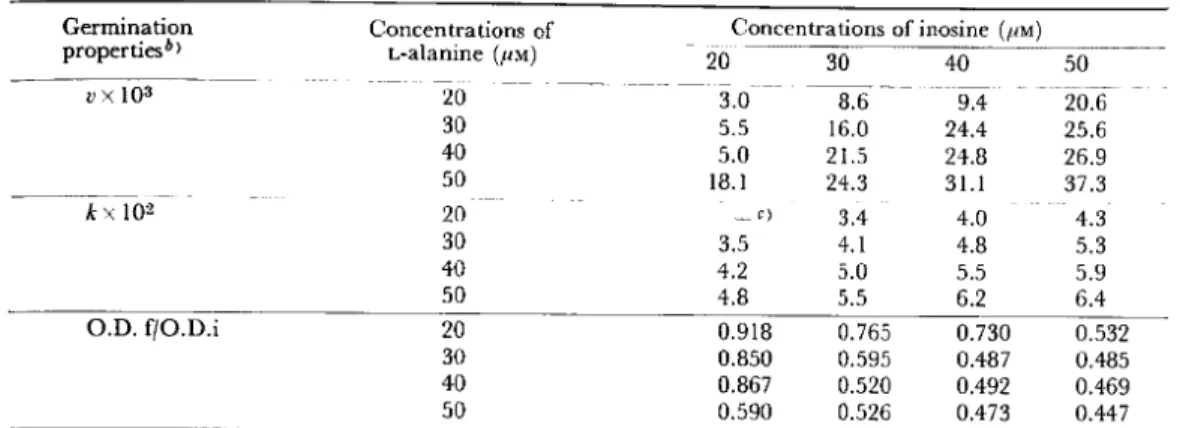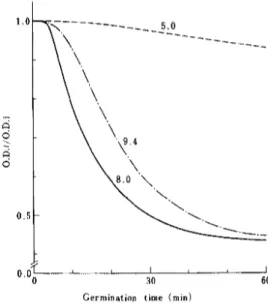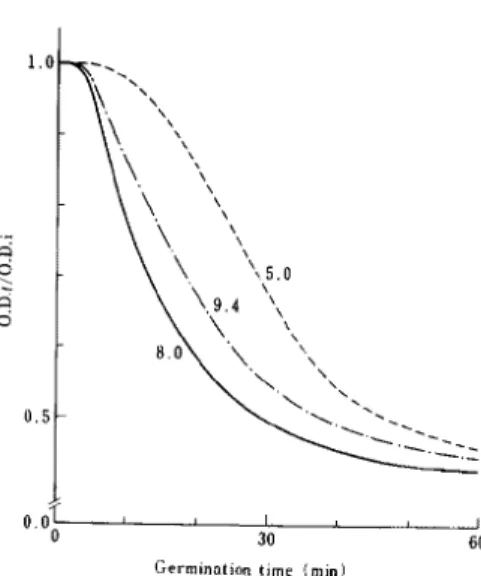Japan. J. Microbiol.
Vol. 20 (6), 529-535, 1976
Germination
of Unactivated
Spores
of Bacillus
cereus T
Effect
of Preincubation
with L-Alanine
or Inosine
on the Subsequent
Germination
Hirofumi
SHIBATA, Hiroaki
TAKAMATSU, and Isamu TANI
Department of Microbial Chemistry, Faculty of Pharmaceutical Sciences,
University of Tokushima, Tokushima
(Received for publication, June 17, 1976)
ABSTRACT
Heat-activated
spores of Bacillus cereus T germinate
rapidly in the presence of L-alanine alone or
inosine alone.
In contrast,
unactivated
spores can not germinate
in the presence of either germinant
alone but rapidly
in the presence
of both germinants.
The highest level of cooperative
action of
L-alanine and inosine on the germination
was observed when they were present in a ratio 1:1.
Preincu-bations of unactivated
spores with L-alanine or inosine had opposite effects on the subsequent
germina-tion in the presence
of both germinants:
preincubation
with L-alanine
stimulated
the initiation
of
subsequent
germination,
while preincubation
with inosine inhibited
it.
These results suggest that
germination
of unactivated
spores initiated
by L-alanine
and inosine includes
two steps, the first
initiated by L-alanine and the second prompted
by inosine.
The effect of preincubation
of unactivated
spores with L-alanine
was not diminished
by washings.
The pH dependence
of the preincubation
of
unactivated
spores was not so marked as that of the subsequent
germination
in the presence of inosine.
Germination
is initiated
by a number of
compounds
known as germinants
[2].
L-Alanine is one of the most effective
germi-nants and its role in germination
has been
studied by many workers [7, 14, 19].
Vary
and Halvorson [12] suggested that L-alanine
might act as a cofactor
of germination
enzymes, and Woese et al [20] predicted
from a study on kinetic models for
germina-tion that
L-alanine
was not an allosteric
effector but
a substrate
for germination
enzymes.
On the other hand, it was
pro-posed that L-alanine had two separate
func-tional
roles in germination
of spores of
Bacillus subtilis by Wax et al [17, 18] and
in Bacillus cereus by Warren and Gould [14].
Recently,
Watabe
et al [15, 16] observed
that two distinct
modes of 14C-L-alanine
uptake were shown during germination of
spores of Bacillus thiaminolyticus.
Purine ribosides are also effective
germi-nants for various species of spores [2, 5, 6, 9].
In particular, it was pointed out that inosine
greatly stimulated germination in the
pre-sence of L-alanine [1, 5, 14, 22]. Among B.
cereus spores, even dormant spores (in the
sense of unactivated spores) germinated in
the presence of L-alanine and inosine at very
low concentrations, even though they could
not germinate in the presence of either
germinant alone, except for aged or activated
spores [22].
In this paper, we discuss the roles of
L-alanine and inosine in the early stage of
germination of B. cereus
T spores initiated by
both germinants.
MATERIALS
AND METHODS
Preparation of spores. B. cereus T (obtained
from Dr. T. Hashimoto, Loyola University
of Chicago, Strich School of Medicine) was
Requests for reprints should be addressed to Dr.
Isamu Tani, Department
of Microbial Chemistry,
Faculty of Pharmaceutical
Sciences, University of
Tokushima,
Shomachi
1-chome, Tokushima,
770
Japan.
used throughout this work. Spores were formed in modified G medium [3] as follows
[10].
Cells from a stock culture of B. cereus T were cultivated on nutrient agar at 30 C for 15 hr. Two loopfuls of this culture were inoculated into 200 ml of G medium and incubated on a reciprocal shaker (Iwashiya
Co., 150 rpm) at 30 C for 4.5 hr. Then, 20 ml of this culture were transferred to a
flask containing 200 ml of fresh G medium, and the flask was shaken for 2.5 hr in the same way. After this procedure was re-peated, the final culture was incubated under the same conditions to complete the sporu-lation process.
Free spores were collected and washed five to eight times with chilled, redistilled water by centrifugation at 4 C. Then they were lyophilized and stored in a desiccator at 5 C. Fresh spore suspensions were pre-pared as required and used within a week.
Heat activation. Fifty milligrams of spores were suspended in 10 ml of deionized water and this suspension was heated at 70 C for 30 min. The spores were collected and washed once with chilled, deionized water by centrifugation at 4 C. Then they were resuspended in 10 ml of deionized water.
Preincubation. Preincubation of unactivat-ed spores with either L-alanine or inosine prior to germination was performed as required.
Unactivated spores (0.5 mg) were incu-bated in 3.0 ml of the medium containing 0.5 or 5•~10-2 mM L-alanine (or inosine) for a certain time. Subsequently, 0.5 or 5•~10-2 mM inosine (or L-alanine) was added and germination was observed. The filtration technique was used as required. After preincubation was performed in the same way, the spores were separated and washed twice with 10 ml of chilled, deionized water by filtration using a membrane filter (Toyo Roshi Co., Ltd., TM-2, 0.45 ƒÊm) at 4 C. Then the spores were resuspended in chilled, deionized water.
Unless otherwise indicated, preincubation was performed at 30 C for 60 min in 0.1 M sodium phosphate buffer (pH 8.0).
Germination. Germination was followed by measuring decreases in the optical density (O.D.) of a spore suspension at 520 nm as follows.
A spore suspension (5 mg/ml) was dropped
into 3 ml of medium and adjusted to a final
O.D. of approximately 0.8. The mixture
was quickly shaken, and the decrease in O.D.
was measured in a Hitachi 124
spectro-photometer equipped with an automatic
recording apparatus.
Unless otherwise
in-dicated, all experiments were performed at
30 C in 0.1 M sodium phosphate buffer (pH
8.0) containing various concentrations of
germinants.
Germination was expressed as
O.D.t/O.D.i, where O.D.i is the initial O.D.
and O.D.t is that after incubation for t min.
Analysis
of germination. It has been pointed
out by many workers that the occurrence of
germination in a spore suspension is
asyn-chronous and its kinetics reflect the
summa-tion of events occurring in the individual
members of the populations [4, 8, 11, 13].
Therefore, to compare the germination
pro-cess under various experimental conditions,
we used three parameters, v, k and O.D.f/
O.D.i; where v is the maximum value
obtained
by numerically
differentiating
[1-(O.D.t/O.D.i)]
with respect to a unit time
(1 min), k is a reciprocal of the time at which
v is obtained, and O.D.f/O.D.i is a final
value of O.D.t/O.D.i.
For simplicity, O.D.f
was usually taken as an O.D. after
incuba-tion for 60 min. Under a given condiincuba-tion,
v is the maximal germination rate per min
and k is proportional to the reciprocal of the
time required for half of the spore
popula-tion to complete its germinapopula-tion.
Chemicals. Chemicals
were
purchased
from Wako Pure Chemical Industries, Ltd.
with the following exceptions: inosine was
from Kohjin Co., Ltd. and yeast extract was
from Difco Laboratories.
RESULTS
Effects of Concentrations
of L-Alanine and Inosine
It is well known that heat-activated spores
of B. cereus T can germinate in the presence
of either L-alanine alone or inosine alone
[1, 6, 14, 22]. In contrast, unactivated spores
do not germinate in the presence of either
germinant alone but germinate
rapidly
without heat activation in the presence of
L-alanine and inosine [22]. We also obtained
similar results.
The germination of unactivated spores in
the presence of L-alanine and inosine
(Ala-GERMINATION
OF UNACTIVATED
SPORES
531
Ino-induced germination) was observed at
various concentrations of both germinants.
As shown in Table 1, the values of v and k
increased with higher concentrations of
either germinant,
while O.D.f/O.D.i
de-creased. A marked decrease in O.D. was not observed at concentrations of either
ger-minant of less than 1•~10-2 mM (O.D.f/ O.D.i>0.9, data are not shown). When comparing v or k obtained at the same levels
Table
1.
Effects
of concentrations
of L-alanine
and inosine
on germination
properties
of unactivated
spores
of B. cereus Ta)
a) Germination
was performed
at 30 C in 0.1 M sodium phosphate
(pH 8.0) containing
L-alanine
and inosine at various concentrations.
b) The values of v, k and O.D.f/O.D.i
were obtained from curves of the optical density at 520 nm
as described
in the Materials
and Methods.
c) Not determined.
Fig, 1. Effect of preincubation time with L-alanine on the subsequent germination in the presence of L-alanine and inosine. Preincubation and germina-tion were performed at 30 C in 0.1 M sodium phosphate buffer (pH 8.0). Concentrations of L-alanine and inosine were 5•~10-2 mM. O.D.t/ O.D.i is the ratio of the optical density at a given time to the initial optical density at 520 nm. Numbers indicated represent time of preincuba-tion in min.
Fig. 2. Effect of preincubation time with inosine on the subsequent germination in the presence of L-alanine and inosine. Preincubation and germina-tion were performed at 30 C in 0.1 M sodium phosphate buffer (pH 8.0). Concentrations of L-alanine and inosine were 5•~10-2 mM. O.D.t/ O.D.i is the ratio of the optical density at a given time to the initial optical density at 520 nm. Numbers indicated represent time of preincuba-tion in min.
Table
2.
Effects
of preincubation
time with
either
L-alanine
or inosine
on
subsequent
germination
of spores
of B. cereus Ta)
a) Unactivated spores were preincubated at 30 C in 0
.1 M sodium phosphate (pH 8.0) containing 5•~10-2 mM L-alanine or 5•~10-2 mM inosine, and then germinated at 30 C in 0 .1 M sodium phos-phate (pH 8.0) containing 5•~10-2 mM L-alanine and 5•~10-2 mM inosine. The values of v, k and O.D.f/O.D.i were obtained from curves of the optical density at 520 nm as described in the Materials and Methods.
b) Not determined .
(molar concentration) of total germinants (L-alanine plus inosine), the highest value was obtained at the same concentration of both germinants.
Effects of Preincubation with L-Alanine or Inosine To determine which germinant was initial-ly effective in the Ala-Ino-induced germina-tion, unactivated spores were preincubated in the presence of either germinant alone (5•~10-2 mM) at 30 C for various times, and the courses of Ala-Ino-induced germination (5•~10-2 mM, respectively) were observed. The results obtained are shown in Figures 1 and 2, and summarized in Table 2. During preincubation for 60 min, no O.D. decrease was observed.
When the time of preincubation with L-alanine was increased (Fig. 1), v did not change significantly for the first 15 min, and then increased rapidly, reaching almost the maximum value after preincubation for 45 min. The value of k reached a maximum after incubation for 30 min. The O.D.f/ O.D.i (0.481•}0.009) did not change ap-preciably with the preincubation time.
The increase in the time of preincubation with inosine (Fig. 2) caused marked changes in both v and O.D.f/O.D.i but not in k. When spores were preincubated with inosine for 60 min, they did not germinate at all.
These results indicate that preincubation of unactivated spores with either L-alanine or inosine alone had opposite effects on their subsequent germination in the presence of both germinants: preincubation with
L-alanine
stimulated
the
initiation
of
the
ger-mination
(Fig.
1),
while
that
with
inosine
inhibited
it (Fig.
2).
Effects
of Temperature
on Preincubation
Unactivated
spores
were
preincubated
with
5•~10-2 mM
L-alanine
at
4-90
C
for
30 min.
After
the
addition
of
5•~10-2 mM
inosine,
their
subsequent
germination
was
observed
at
30 C.
The
results
are
shown
in
Figure
3
by
plotting
k
and
O.D
.f/O.D.i
against
temperature
during
preincubation
.
The
plot
of k gave
a rapid
rise
at
20-30
C
,
a rapid
fall
at 70-90
C and
a plateau
between
30
C and
70 C.
The
highest
value
of k was
shown
at 65
C.
On
the
other
hand,
the
plot
of
O.D.f/O.D.i
showed
a rapid
fall
at
20-30
C,
a
rapid
rise
at
85-90
C
and
a
plateau
between
30
C
and
80
C.
These
results
in-dicate
that
the
optimum
temperature
range
for
preincubation
was
about
30-70
C .
Effects
of pH
of the Medium
on Preincubation
and
Subsequent
Germination
Spores
were
preincubated
for
60 min
at
pH
8.0
with
0.5 mM
L-alanine
and
washed
twice
with
deionized
water
by
filtration,
and
the
subsequent
germination
was
observed
at
pH
5.0,
8.0
and
9.4
in
the
presence
of
0.5
mM
inosine
alone
(Fig.
4).
The
spores
germinated
at
pH
8.0
which
shows
that
the
effect
of
L-alanine
during
preincubation
appeared
in
the
subsequent
germination
even
after
the
spores
were
washed.
They
could
also
germinate
at
pH
GERMINATION
OF UNACTIVATED
SPORES
533
Fig. 3. Effect of preincubation temperature on subsequent germination. Unactivated spores of B. cereus T were preincubated at various tempera-tures for 30 min in 0.1 M sodium phosphate (pH 8.0) containing 5•~10-2 mM L-alanine, and their germination was observed at 30 C in 0.1 M sodium phosphate (pH 8.0) containing 5•~10-2
mM L-alanine and 5•~10-2 mM inosine. The k (•œ) and the O.D.f/O.D.i (•›) are plotted against preincubation temperature. The k was obtained from curves of the optical density at 520 nm as described in the Materials and Methods. The O.D.f/O.D.i is the final value of O.D.t/O.D.i.
Fig. 4. Effect of pH of the medium on subsequent
germination. Unactivated spores of B. cereus T
were preincubated at 30 C for 60 min in 0.1 M
sodium phosphate (pH 8.0) containing 0.5 mM
L-alanine, and subsequent germination was
ob-served at 30 C in 0.1 M sodium phosphate (pH 5.0,
8.0 and 9.4) containing 0.5 mM inosine. O.D.t/
O.D.i is the ratio of the optical density at a given
time to the initial optical density at 520 nm.
Numbers indicated represent pH of subsequent
germination media.
that the subsequent germination
in the
pre-sence of inosine alone may be identical to
the germination
in the presence
of both
germinants [14].
In contrast, when unactivated
spores were
preincubated
at pH 5.0 and 9.4, they
germi-nated at pH 8.0 to the same degree as the
spores preincubated
at pH 8.0 (Fig. 5).
However, in the subsequent
germination
of
the spores preincubated
at pH 5.0, slight
retardation
of the germination
was observed.
DISCUSSION
The most effective germination
of B. cereus
T spores is initiated by L-alanine in the
pre-sence of purine
ribosides [1, 2].
Warren
and Gould [14] suggested that the presence
of an amino acid was essential for
germina-tion of spores of B. cereus T in the presence
of purine ribosides.
Furthermore,
Yousten
[22] pointed out that inosine alone did not
bring
about
a pregerminative
structural
change in spores such as that caused by
L-alanine for more rapid germination.
In comparisons of data on germination of unactivated spores at the same levels of total germinants (L-alanine plus inosine), the highest values of v were found at the same concentrations of both germinants (Table 1). This suggests that the cooperative action of both germinants is a maximum when they are present in a ratio 1:1.
Preincubations of unactivated spores of B. cereus T with either 5•~10-2 mM L-alanine
or inosine had opposite effects on subsequent germination in the presence of concentra-tions of 5•~10-2 mM of both germinants. Ala-Ino-induced germination was stimulated by preincubation with L-alanine (Fig. 1) but inhibited by that with inosine (Fig. 2).
Jones and Gould [5] and Yousten [22] reported that inosine might enhance the activity of alanine racemase. From this point of view, it is possible that the inhibition of subsequent germination of the spores pre-incubated with inosine may be due to the effect of D-alanine which was converted from L-alanine by active alanine racemase.



